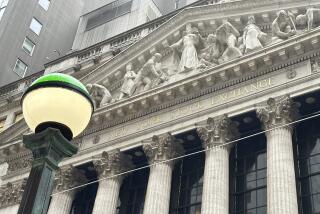Investors in Bond Funds Should Be Asking: What If?
- Share via
If you haven’t looked at your bond mutual fund’s share price lately, doing so now may cause sudden nausea. As bonds’ devastating bear market moves into its second year, investors’ principal losses are mounting again.
The latest surge in interest rates has driven new bond yields to 2 1/2-year highs, further depressing the value of older, lower-yielding bonds stuck in fund portfolios. Share prices of longer-term bond funds have dropped as much as 2% just since Sept. 30, after plunging as much as 10% to 15% over the prior 12 months, as interest rates have crept up almost nonstop.
Bond fund owners are still earning interest, of course, but those earnings may not come close to making up for the loss in share value this year.
Yet if the question is how much more pain bond fund owners can take, the answer evidently is plenty. Despite the renewed pummeling the bond market is taking, many mutual fund companies say there has been little or no acceleration of shareholder redemptions from bond funds in recent weeks.
At Massachusetts Financial Services in Boston, for example, a spokesman says the firm’s government and corporate bond funds (total assets: $8 billion) have seen $59 million flow out so far this month from redemptions. That is down from a $70 million net cash outflow in September.
*
Boston-based Scudder Funds also is losing less this month in bond fund outflows than in September, says spokesman Gavin Quill. And the Vanguard Group in Valley Forge, Pa., says its bond fund redemptions haven’t changed significantly compared to September.
The October numbers are a continuation of the trend the fund industry has lived with since early summer. After suffering a massive $7.7-billion net cash outflow in March as interest rates rocketed, bond funds overall lost a net $2.2 billion in May, $1.7 billion in June, $2.9 billion in July and $2.8 billion in August.
In other words, money has been slowly trickling out--not pouring out. Total assets of bond funds stood at $728 billion at the end of August, the latest figure available. Which means most investors are sitting tight in the face of deep principal losses.
In fact, Scudder’s Quill says the rate at which bond fund shareholders are selling out of the funds isn’t dramatically different this year compared to the last few years. “Things have been very much within the three- to four-year historical norm” for redemptions, he says. The difference this year is that people have stopped pumping new money into the funds, he says.
The vast majority of bond fund investors’ willingness to stay put in the funds--amid one of the worst bond bear markets in history--raises some interesting questions. Do people understand how much they’ve lost in principal value? Is it that they don’t care, because they own bonds solely for the income they produce?
Or do most bond fund owners view themselves as long-term investors, and expect to make up 1994’s losses when interest rates decline again?
While long-term investing has proven merit, the danger is that fund owners who say they’re in for the long haul today just haven’t been clawed badly enough by this bear market. If market interest rates continue to rise for the next six to 12 months--driving bond fund share prices ever lower--the possibility remains that the relative trickle out of the funds will turn into a torrent.
Naturally, few Wall Streeters believe interest rates can go much higher. With the 30-year Treasury bond yield now at 8.04%, compared to 5.79% at its low a year ago, most investment pros will argue that we’re closer to the end of rates’ rise than to the beginning of a new upward spiral.
But bond fund owners, especially those in funds that own long-term issues, should be asking a big “What if?” today: What if the experts are wrong--as they have been all year--and interest rates jump again in 1995, as the world economy grows at a robust pace? How much more of a paper loss are you willing to endure? Is it worth the risk of staying in a long-term bond fund that yields, say, 7.5% when you can now earn 6.2% virtually risk-free in a one-year Treasury bill?
Sitting tight in a losing but otherwise solid investment can be a winning strategy if you can truly stick with it and wait for the next bull market. The problem is that most people panic and sell when the pain finally becomes too great. That threshold apparently hasn’t yet been reached for most bond fund investors, but that doesn’t mean the day won’t come.
Eroding Again
How some bond mutual funds’ share prices have slid from Jan. 1 and Sept. 30 to this week. Prices listed are “net asset value” per share, or NAV.
NAV per share, 1994: Fund 1/1 9/30 Tues. Colonial Strat. In. A $7.39 $6.68 $6.67 Dean Witter U.S. Gov. 9.31 8.51 8.40 Fidelity Govt. Sec. 10.34 9.33 9.21 Franklin U.S. Gov. 7.11 6.51 6.41 IDS Selective 9.61 8.68 8.58 Pimco L-T U.S. Gov. 10.70 9.38 9.20 State Farm Interim 10.49 9.88 9.81 T. Rowe Price Tax-Free 9.90 9.02 8.86 Vanguard S-T Federal 10.34 9.85 9.81 Vanguard L-T Treas. 10.57 9.13 8.96
Source: Lipper Analytical Securities Inc.
More to Read
Inside the business of entertainment
The Wide Shot brings you news, analysis and insights on everything from streaming wars to production — and what it all means for the future.
You may occasionally receive promotional content from the Los Angeles Times.










